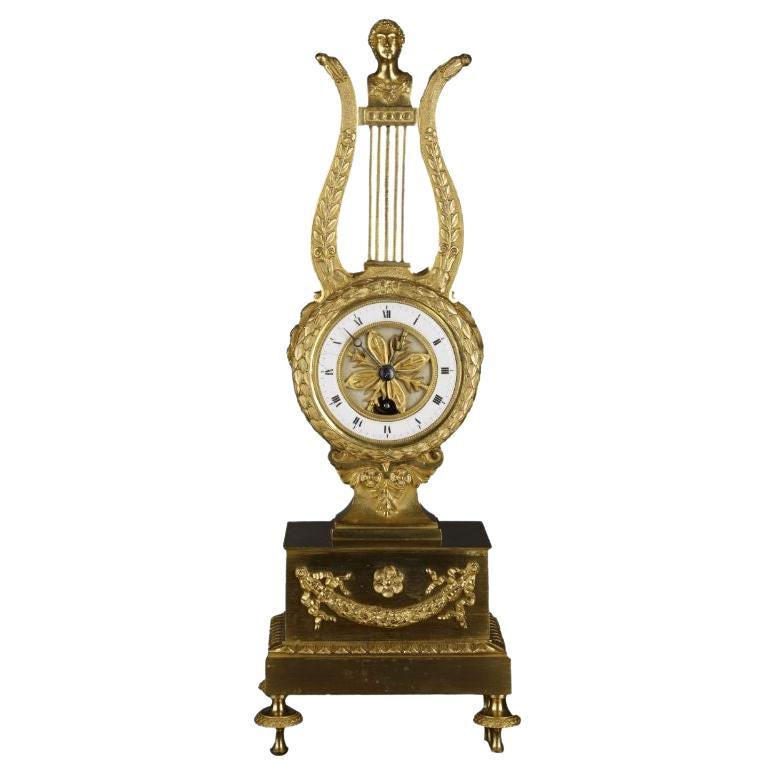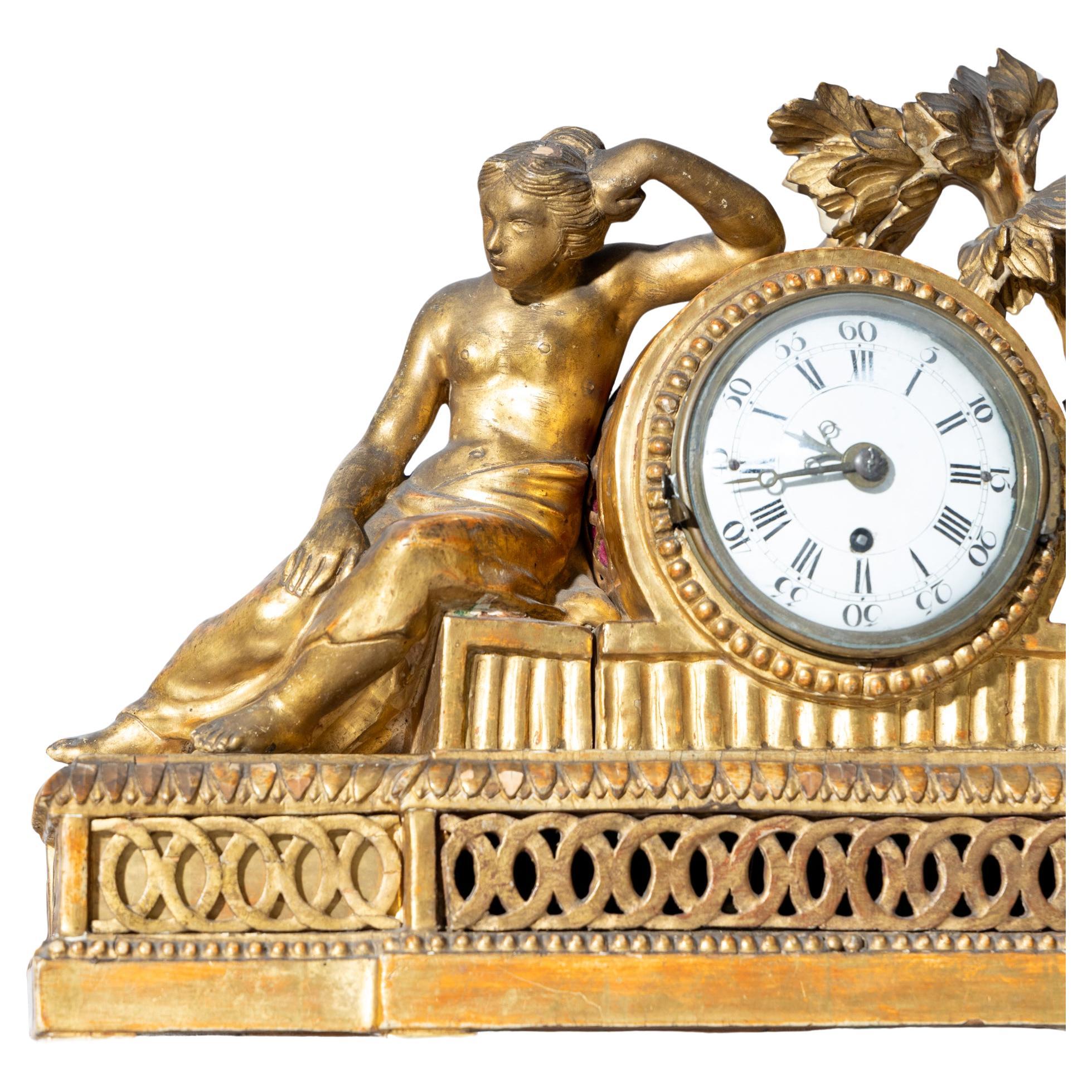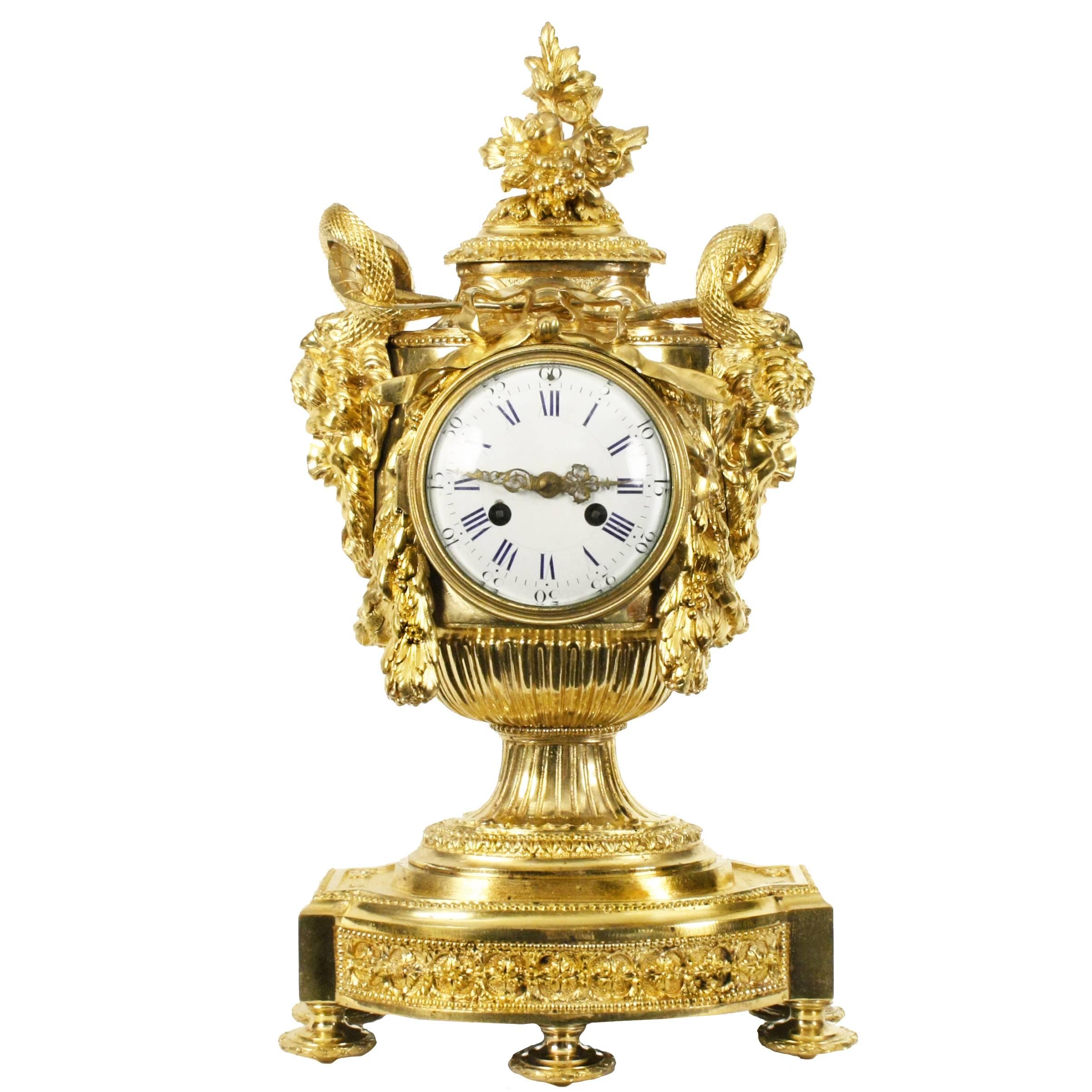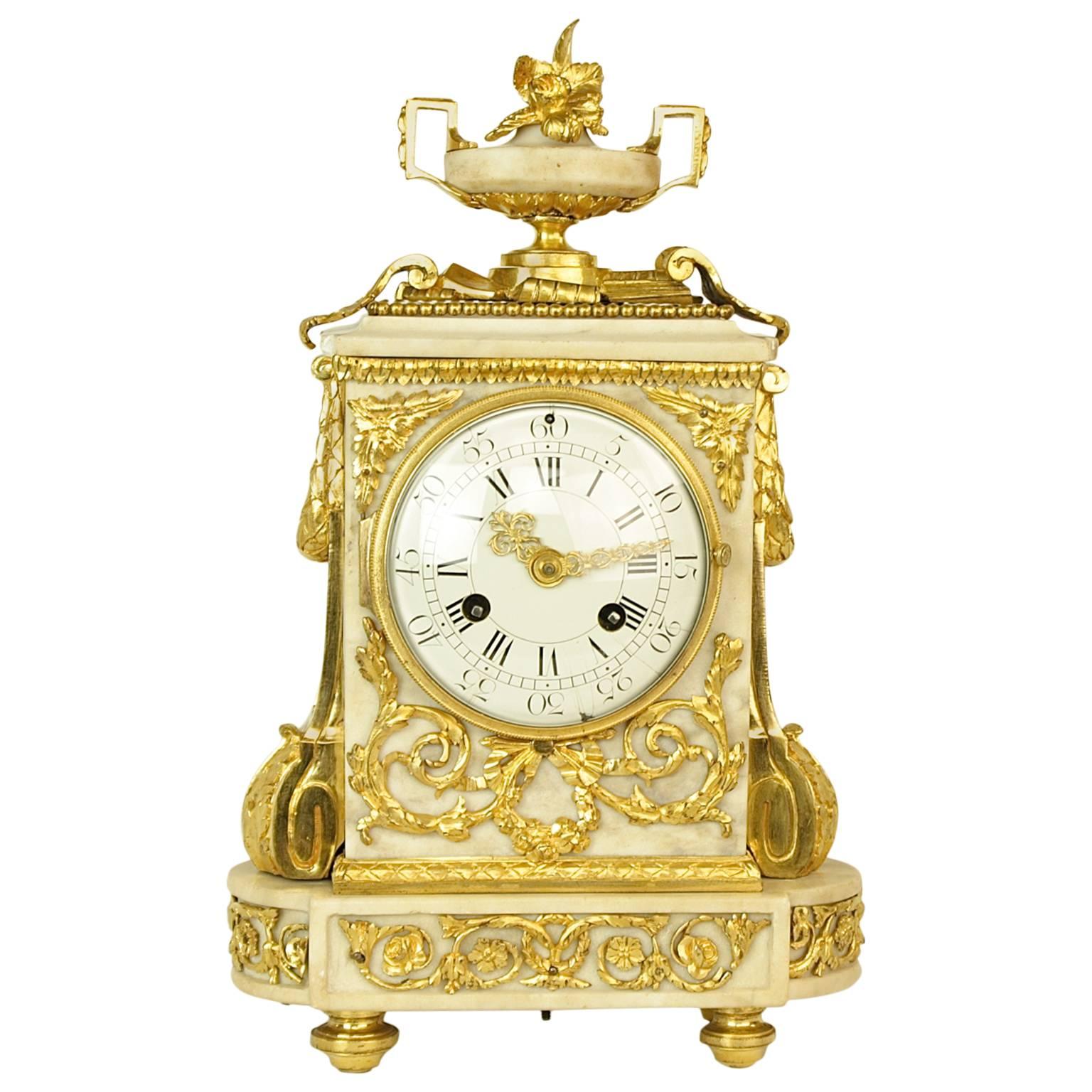Items Similar to Louis Seize Lyre Mantel Clock, Probably Paris, circa 1780
Want more images or videos?
Request additional images or videos from the seller
1 of 9
Louis Seize Lyre Mantel Clock, Probably Paris, circa 1780
About the Item
Lyre-shaped mantel clock on marble base with crowning head of sun god Apollo and swan heads holding a flower festoon in their beaks. The dial is decorated with round enamel numerals. Fire-gilded bronze. Type illustrated in: Elke Niehüser: French Bronze Clocks, o.A. 1999, p. 258, fig. 1226.
- Dimensions:Height: 18.9 in (48 cm)Width: 7.49 in (19 cm)Depth: 4.93 in (12.5 cm)
- Style:Louis XVI (Of the Period)
- Materials and Techniques:
- Place of Origin:
- Period:1780-1789
- Date of Manufacture:circa 1780
- Condition:Refinished. Wear consistent with age and use.
- Seller Location:Greding, DE
- Reference Number:
About the Seller
4.9
Gold Seller
These expertly vetted sellers are highly rated and consistently exceed customer expectations.
Established in 1987
1stDibs seller since 2013
446 sales on 1stDibs
Typical response time: 8 hours
- ShippingRetrieving quote...Ships From: Greding / Röckenhofen, Germany
- Return PolicyA return for this item may be initiated within 7 days of delivery.
More From This SellerView All
- Louis Seize Mantel Clock in a Giltwood Case, End of 18th CenturyLocated in Greding, DELouis Seize mantel clock or pendule, housed in a gold-patinated wooden case featuring intricate openwork rings and a round clock case. The design depicts a young undressed woman lean...Category
Antique Late 18th Century French Louis XVI Mantel Clocks
MaterialsBrass
- Fire-Gilt Mantel Clock, France / Paris, circa 1830Located in Greding, DEFrench mantel clock made of burnished and fire-gilded bronze with an enamelled dial, there inscribed "'a Paris". The pendulum stands on a rectangular base with turned moulding, above...Category
Antique 1830s French Charles X Table Clocks and Desk Clocks
MaterialsBronze, Enamel
- Charles X Mantle Clock, Signed Jeannest, Paris, circa 1830Located in Greding, DEFrench pendule clock, the base, pedestal and columns are out of white marble. The silvered clockface with Roman numerals is inscribed Jeannest à Paris.Category
Antique 1830s French Charles X Table Clocks and Desk Clocks
MaterialsMarble, Silver
- Bronze Mantel Clock, Restauration Period France, Movement Dated 1827Located in Greding, DEThe large pendulum on a Sienese marble base with patinated bronze frieze as well as large fully sculpted depiction of a bearded man with the index finger at his temple. The other han...Category
Antique 19th Century French Restauration Mantel Clocks
MaterialsBronze
- Alabaster Mantel Clock, sig. McDonald Glasgow, 19th centuryLocated in Greding, DEMantel clock in an alabaster case with Roman hours, cobalt blue and gilded decoration in the form of caryatids, flaming urns and a winged putto riding a butterfly. The clock stands o...Category
Antique 19th Century Mantel Clocks
MaterialsAlabaster
- Empire Mantel Clock with reading young lady, early 19th centuryLocated in Greding, DEEmpire mantel clock with enameled dial and fire-gilt case. The clock is crowned by a full-figure young lady sitting on a Klismos chair and reading a book. Her feet rest on a stool an...Category
Antique Early 19th Century Empire Mantel Clocks
MaterialsMetal
You May Also Like
- French Ormolu Lyre Mantel ClockLocated in Norwich, GBFrench ormolu Lyre clock standing on a stepped rectangular base with acanthus leaf decoration and floral swags resting on four turned and chased toupe feet. Chased garland gilt bezel surrounding a fine enamel dial with Roman numerals and a gilded starburst...Category
Antique 1840s French Mantel Clocks
MaterialsOrmolu
- Unusual Louis XVI mantel clock by Gavelle a ParisLocated in HAARLEM, NLA good and very unusual Louis XVI mantel clock in a form of a soldier with the drum on his back carrying the movement. The lovely patinated bronze mounted on a typical early Louis XV...Category
Antique 18th Century French Louis XVI Mantel Clocks
MaterialsBronze
- Raingo Fres, Paris. Louis XVI Style Mantel ClockBy Raingo FrèresLocated in Brighton, SussexA very good quality 19th century French gilded ormolu and white marble mantel clock, having a central urn, flanked by Pan like figures each with hoof feet. Swags and drapes of foliag...Category
Antique 19th Century French Louis XVI Mantel Clocks
MaterialsMarble, Ormolu
- Louis XVI Style Ormolu Mantel Clock Freres ParisLocated in New York, NYStyle of Robert Osmond, circa 1776. Movement signed 'Freres, Paris,' third quarter of the 19th century.Category
Antique 19th Century French Louis XVI Mantel Clocks
MaterialsBronze
- 18th Century Louis XVI Gilt-Bronze and White Marble Mantel Clock, circa 1780Located in Berlin, DEAn 18th Century Louis XVI Gilt-Bronze and White Marble Mantel Clock, circa 1780 An 18th century Louis XVI gilt-bronze and white marble clock, the white enamel dial with Roman and Ar...Category
Antique 1780s French Louis XVI Mantel Clocks
MaterialsCarrara Marble, Enamel, Ormolu
- Sèvres Porcelain Louis XVI Lyre Mantel Clock by Kinable, Dial by DubuissonBy Dieudonné Kinable, DubuissonLocated in Paris, FRDieudonné Kinable Enamel Dial Attributed to Dubuisson (1731-1815) Exceptional Porcelain Lyre Mantel Clock from the Royal Sèvres Porcelain Manufactory Paris, late Louis XVI period, circa 1785-1790 Height 62 cm; width 26 cm; depth 16 cm The round enamel dial, signed “Kinable”, indicates the hours in Roman numerals, the fifteen-minute intervals in Arabic numerals, the annual calendar and the signs of the Zodiac, by means of four hands, two of which are made of pierced gilt bronze, the two others in blued steel. The magnificent lyre-shaped case is made of “bleu nouveau” Sèvres porcelain and finely chased and gilt bronze. The bezel is made up of a gilt bronze twisted rope; the pendulum is adorned with brilliant-cut paste stones; the body of the lyre is adorned with gilt bronze beading and with laurel leaf and seed motifs, with two rosettes issuing floral and foliate swags. The clock is surmounted by a mask with radiating sunrays. The spreading foot is decorated with beading and twisted rope motifs and a leafy garland. The en-suite decorated oval base is raised upon four flattened ball feet. The Royal Sèvres Porcelain Factory produced the lyre clock model as of 1785. Four colours were offered: turquoise, green, pink and bleu nouveau. These exceptional clocks were made for the connoisseurs of the time. Louis XVI had a similar clock in his Salon des jeux in Versailles; its dial bore the signature of the clockmaker Courieult (this is almost certainly the example illustrated in P. Verlet, Les bronzes dorés français du XVIIIe siècle, Paris, 1999, p. 41). Kinable, however, was the clockmaker who purchased the greatest number of lyre cases from the factory, and he developed the model in the late 18th century. Among the porcelain lyre clocks signed by this brilliant horologer, one example is in the Victoria & Albert Museum in London (illustrated in H. Ottomeyer and P. Pröschel, Vergoldete Bronzen, Band I, Munich, 1986, p. 252, fig. 4.6.26). A second such clock is in the Royal British Collection (see C. Jagger, Royal Clocks, The British Monarchy & its Timekeepers 1300-1900, 1983, p. 130, fig. 176). Bibliography: M. Gay and A. Lemaire, “Les pendules lyre”, in Bulletin de l’Association nationale des Collectionneurs et Amateurs d’Horlogerie ancienne, Winter 1993, n° 68, p. 5-40. Dieudonné Kinable (active circa 1785-1810) One of the most important Parisian clockmakers of the late 18th century. His shop was located at n° 131 Palais Royal. He purchased a great number of lyre-type porcelain clock cases...Category
Antique 1780s French Louis XVI Mantel Clocks
MaterialsBronze





